Carnegie Learning Algebra I Student Text Volume 1 3rd Edition Chapter 4 Sequences
Page 252 Problem 1 Answer
We have been given a table as,
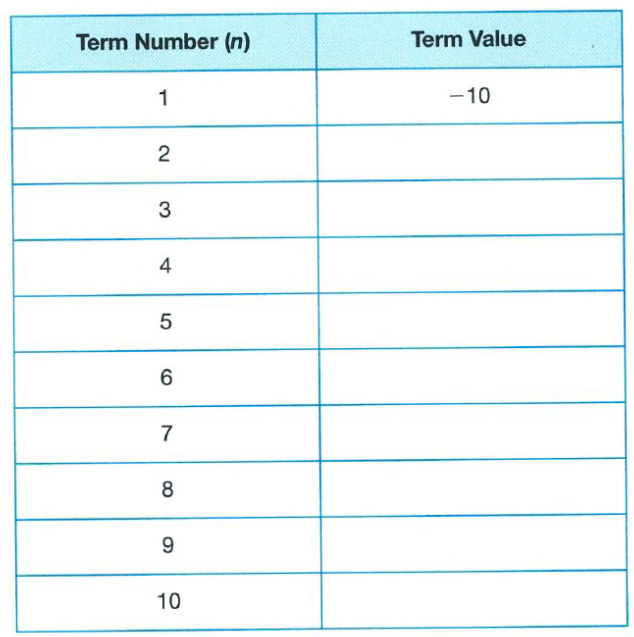
We have to complete the given table.We can complete it using the explicit formula, an
=−10+4(n−1).
We have the table as,
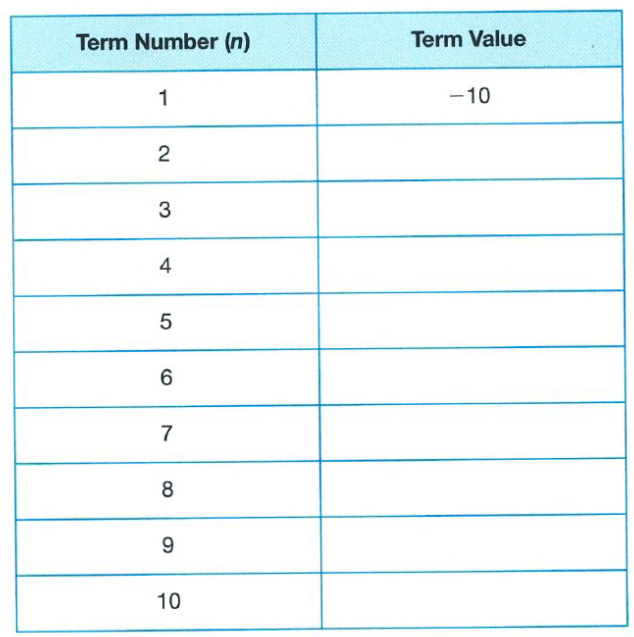
We have the first term as −10.

From the formula, we have the difference as 4 between consecutive sequence terms.
We get the terms as,
a2=−10+4(2−1)
a2=−6
a3=−10+4(3−1)
a3=−2
And a4=−10+4(4−1)
a4=2
a5=−10+4(5−1)
a5=6
And a6=−10+4(6−1)
a6=10
a7=−10+4(7−1)
a7=14
And a8=−10+4(8−1)
a8=18
a9=−10+4(9−1)
a9=22
Also a10=−10+4(10−1)
a10=26
So, we completed the table as,
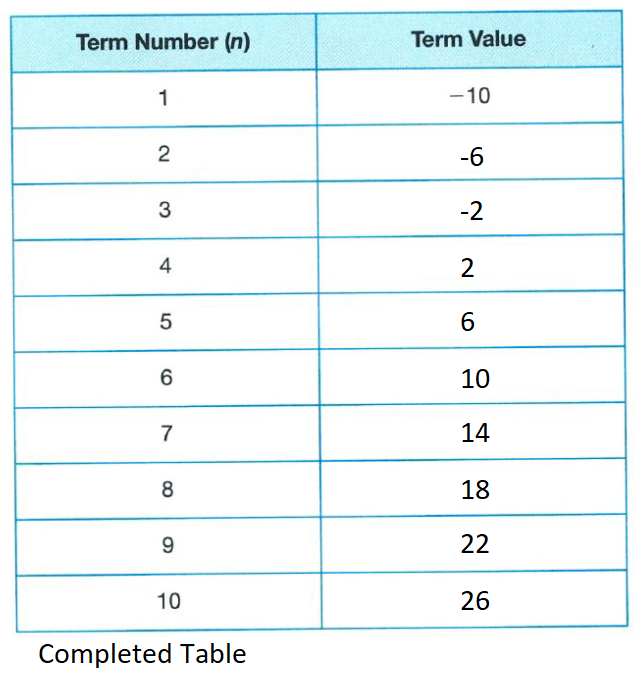
So, for the explicit formula, an =−10+4(n−1), we completed the given table as,
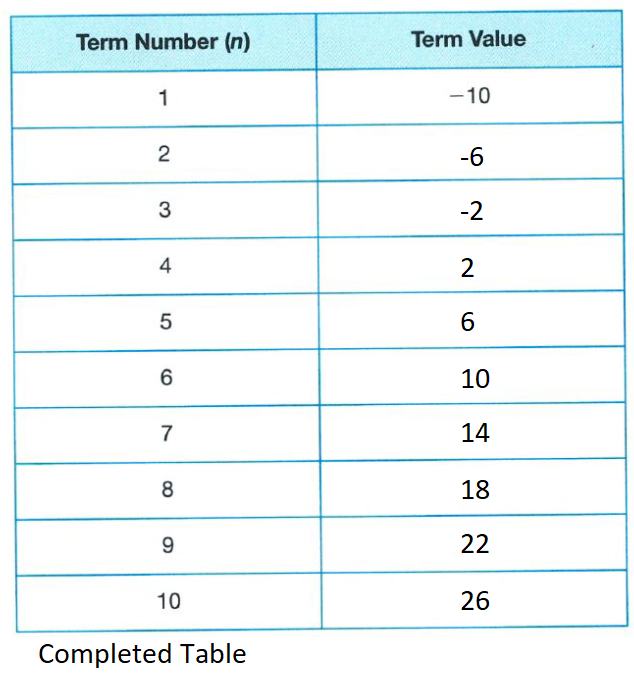
Carnegie Learning Algebra I Chapter 4 Exercise 4.4 Solutions
Carnegie Learning Algebra I Student Text Volume 1 3rd Edition Chapter 4 Exercise: 4.4 Sequences Page 252 Problem 2 Answer
We have the explicit formula as, an=−10+4(n−1). We have to write each pair of numbers from the table as an ordered pair.
We will do it by making the independent variable represent the term number, and letting the dependent variable represent the term value.
We have the table as,
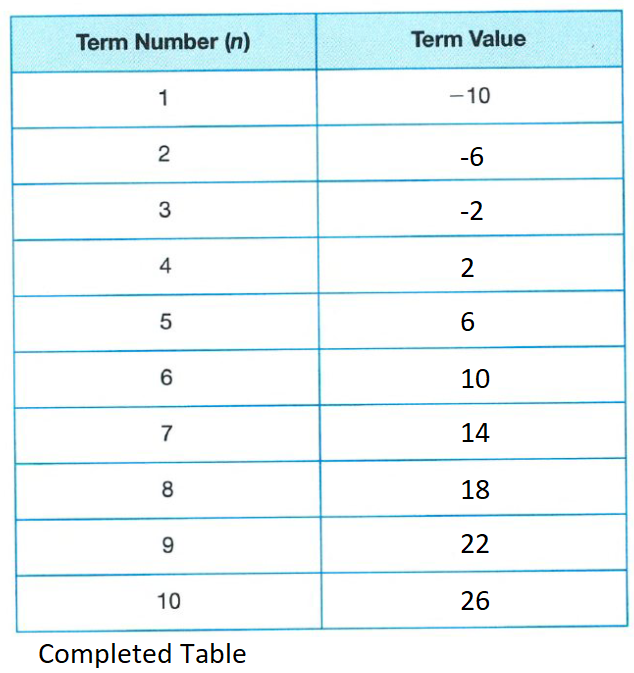
Here independent values are 1,2,3,4,5,6,7,8,9,10.Here the dependent values are −10,−6,−2,2,6,10,14,18,22,26.So, we get the ordered pair as (1,−10),(2,−6),(3,−2),(4,2),(5,6),(6,10),(7,14),(8,18),(9,22),(10,26).
So, using the table,

we wrote each pair of numbers from the table as an ordered pair, as (1,−10),(2,−6),(3,−2),(4,2),(5,6),(6,10),(7,14),(8,18),(9,22),(10,26), where the independent variable represent the term number, and let the dependent variable represent the term value.
Page 252 Problem 3 Answer
We have the explicit formula as, an=−10+4(n−1).
We have to graph the ordered pairs on the grid shown and label the axes.
We will do it with the help of the table.
We have the table as,

We can label the x−axis as a number of terms, and the y−axis as the value of terms.So, we can draw the graph as,

So, we have drawn the graph, and labeled the axis for formula an=−10+4(n−1) as,
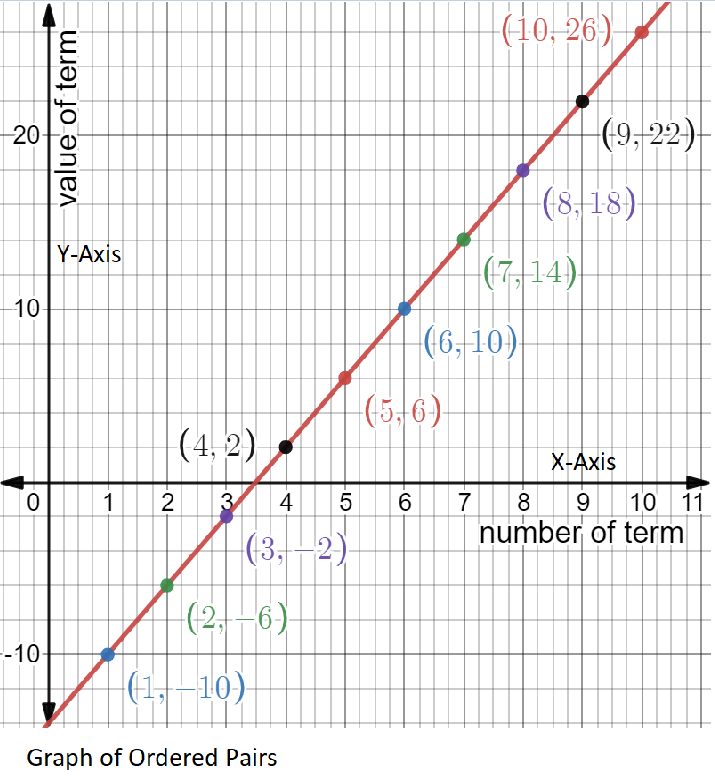
Sequences Chapter 4 Exercise 4.4 Answers
Carnegie Learning Algebra I Student Text Volume 1 3rd Edition Chapter 4 Exercise: 4.4 Sequences Page 252 Problem 4 Answer
We have the explicit formula as, an=−10+4(n−1).
We have to describe the shape of the graph.
We will refer to the graph that we have drawn in the previous question,
We have the graph as,
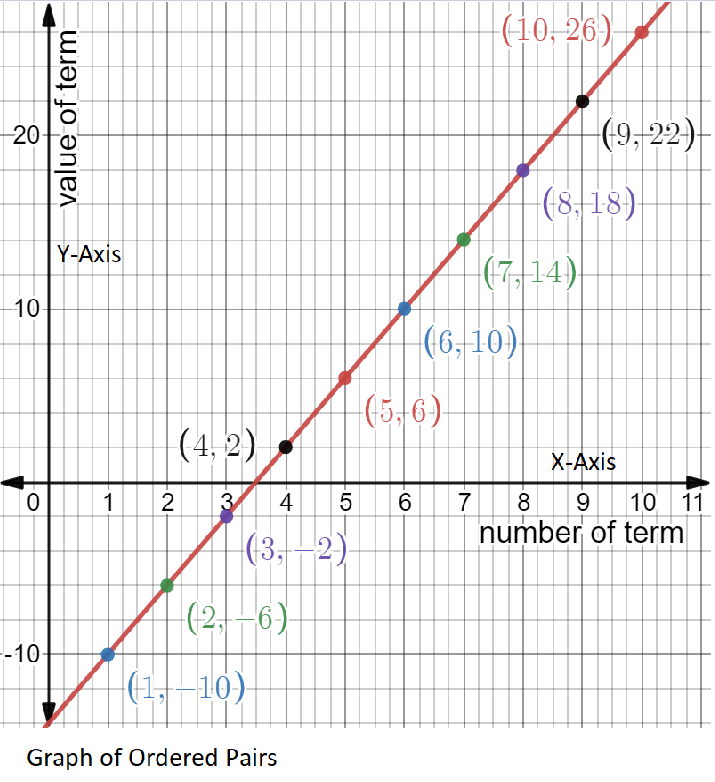
We can say that the graph is in a linear form.
We can also say that the line has a slope of 4.
So, we get the shape of the sequence pattern as a straight line with a slope of 4, given as,
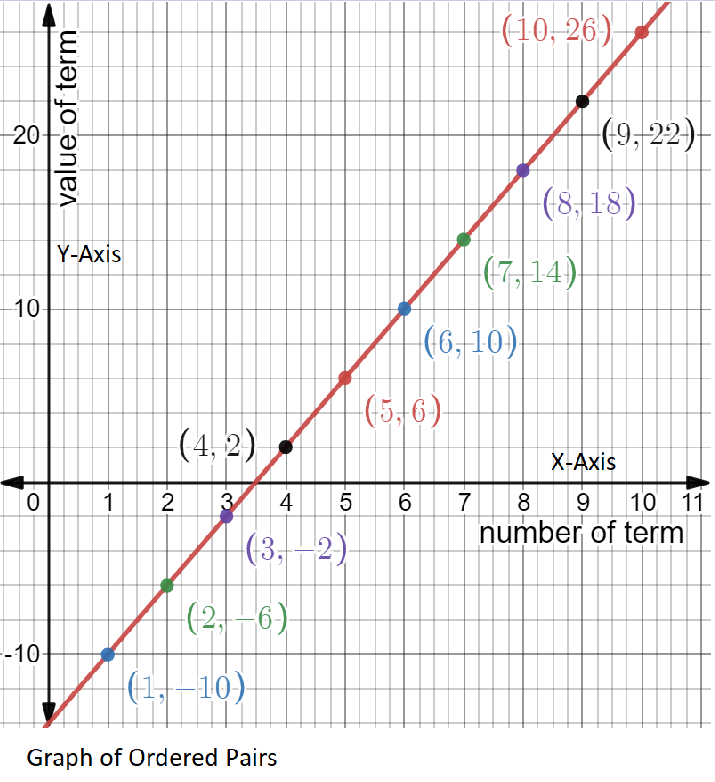
Page 252 Problem 5 Answer
We have the explicit formula as, an=−10+4(n−1).
We have to find the continuity of the graph of an nth term with several terms.
We can use the method of arithmetic sequence.
We have the given arithmetic condition as,an=−10+4(n−1) which represents the arithmetic formula, an=a1+d(n−1)
Comparing these two conditions the values of a1, and d were found as −10,4 respectively.
To find the term values in the table by adding 4.
We have the table as,
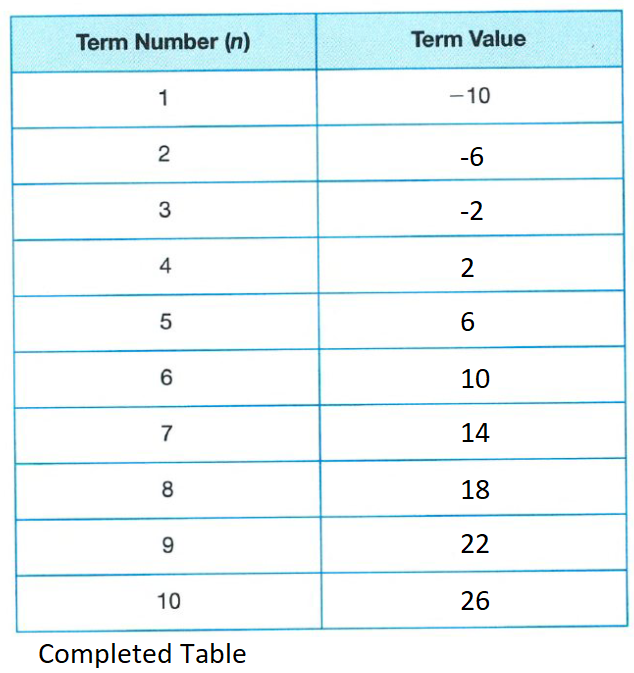
We write the rows in the table in ordered pairs of the form( term number, term value)
(1,−10),(2,−6),(3,−2),(4,2),(5,6),(6,10),(7,14),(8,18),(9,22),(10,26).
We get the graph as,

So, as the number must be natural numbers, we get the graph as discrete, since the continuous functions must have the domain of all real numbers, given as,
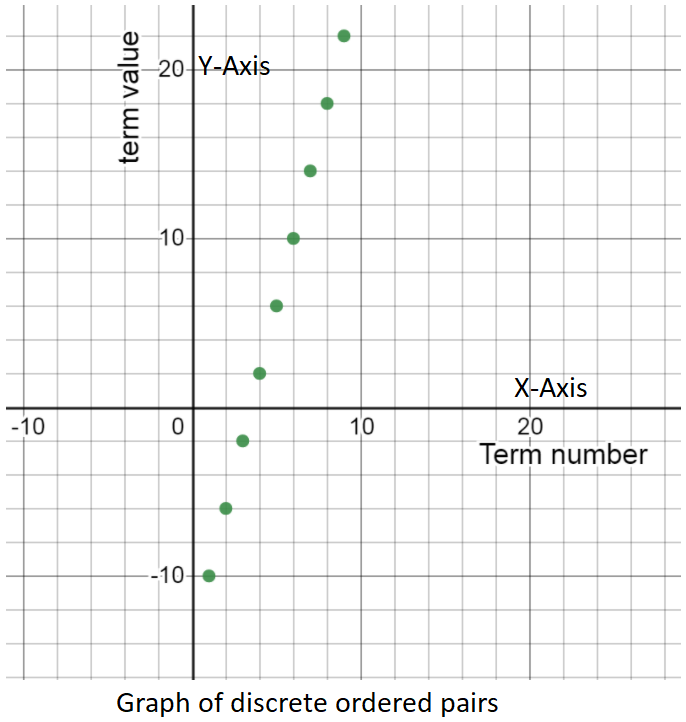
Page 252 Problem 6 Answer
We have the explicit formula as, an=−10+4(n−1).
We have to find the 20th term.
We will use the method of arithmetic sequence.
We can also use the continuous graph to determine the term.
The graph is given as,
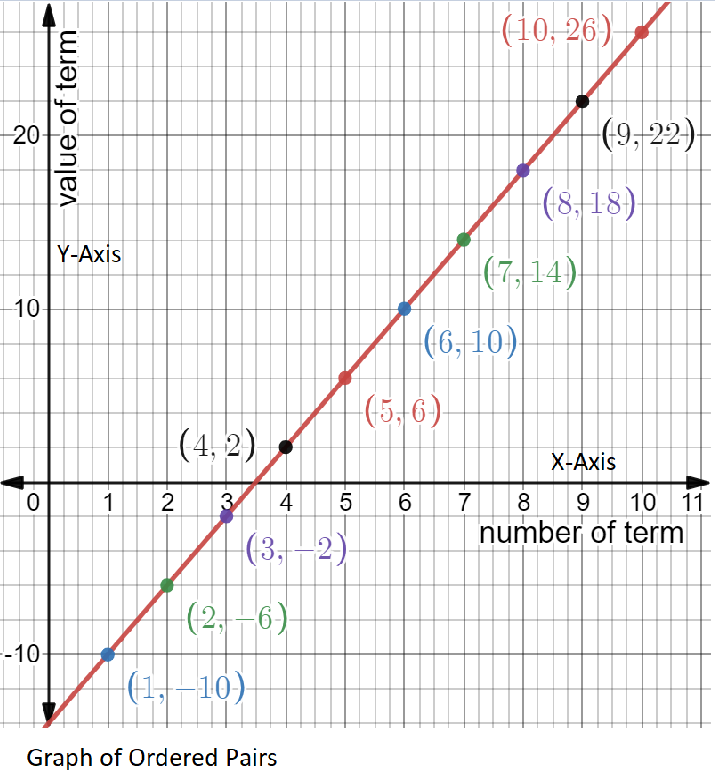
We can find the equation of the line using the two-point form. The coordinate with its abscissa as 20 on the line will give the 20th term.
So, we can determine the 20th term by equating abscissa on the equation of a line given by the graph,
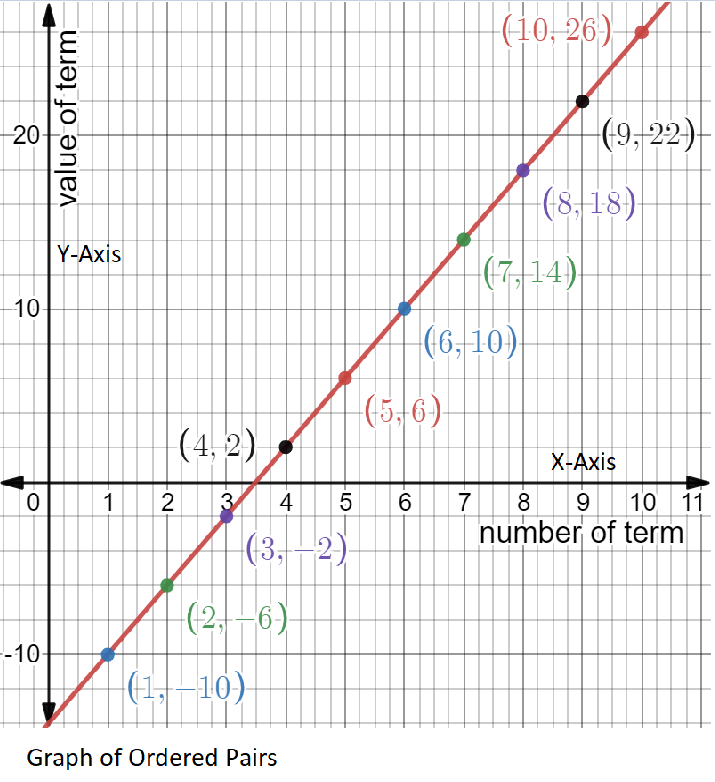
Carnegie Learning Algebra I Student Text Volume 1 3rd Edition Chapter 4 Exercise: 4.4 Sequences Page 254 Problem 7 Answer
We have been given that sequence is represented as,g1=1,gn=2n−1.
We have to find the first ten terms of the sequence and complete the table.
We can find gn=2n−1 for different ten values by substituting them.
We can find the values as,
g2=22−1
g2=2
g3=23−1
g3=4 and
g4=24−1
g4=8
g5=25−1
g5=16 and
g6=26−1
g6=32
g7=27−1
g7=64and
g8=28−1
g8=128
g9=29−1
g9=256 also
g10=210−1
g10=512
We can complete the table as,
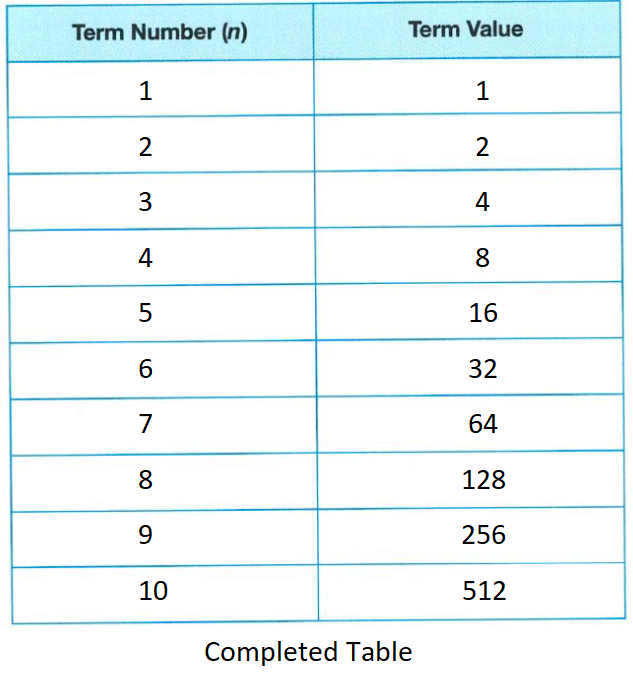
So, using the explicit formula, gn=2n−1, we completed the table as,
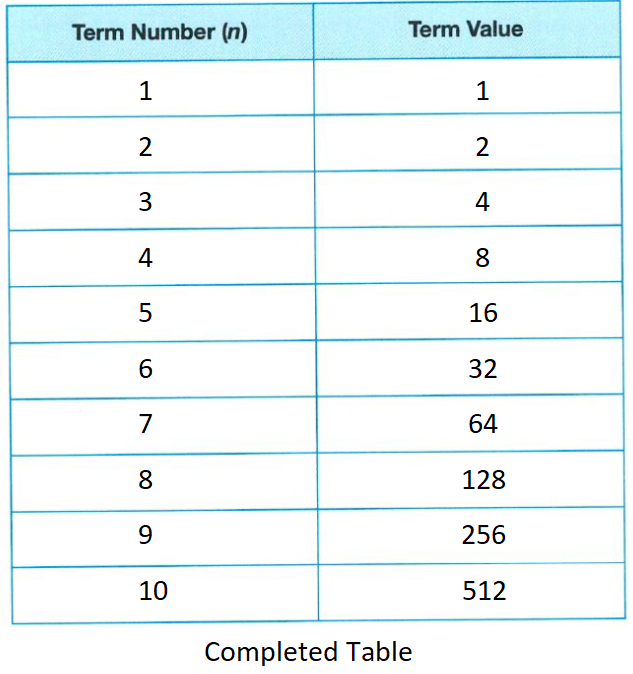
Page 254 Problem 8 Answer
We have been given an explicit formula as, gn=2n−1. We have to write each pair of numbers from the table as an ordered pair.
We will do it by making the independent variable represent the term number, and letting the dependent variable represent the term value.
We have the table as,
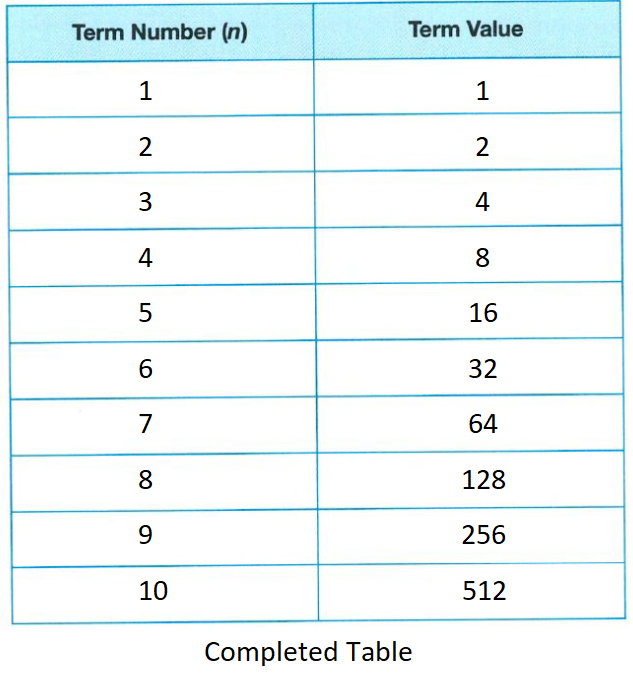
Here independent values are 1,2,3,4,5,6,7,8,9,10.Here dependent values are 1,2,4,8,16,32,64,128,256,512.So, we get the ordered pair as (1,1),(2,2),(3,4),(4,8),(5,16),(6,32),(7,64),(8,128),(9,256),(10,512).
So, using the table,

we wrote each pair of numbers from the table as an ordered pair, as (1,1),(2,2),(3,4),(4,8),(5,16),(6,32),(7,64),(8,128),(9,256),(10,512), where the independent variable represent the term number, and let the dependent variable represent the term value.
Carnegie Learning Algebra I Sequences Exercise 4.4 Solutions
Carnegie Learning Algebra I Student Text Volume 1 3rd Edition Chapter 4 Exercise: 4.4 Sequences Page 254 Problem 9 Answer
We have been given an explicit formula as, gn=2n−1.
We have to graph the ordered pairs on the grid shown and label the axes.
We will do it with the help of the table.
We have the table as,

We can label the x−axis as a Term number and the y−axis as a Term value. So, we can draw the graph as,

So, we have drawn the graph, and labeled the axis for the formula gn=2n−1 as,
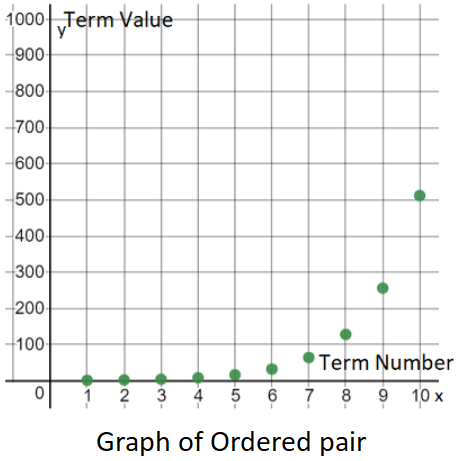
Page 254 Problem 10 Answer
We have been given an explicit formula as, gn=2n−1.
We have to describe the shape of the graph.
We will refer to the graph that we have drawn in the previous question, by joining the points.
We can give the graph as,
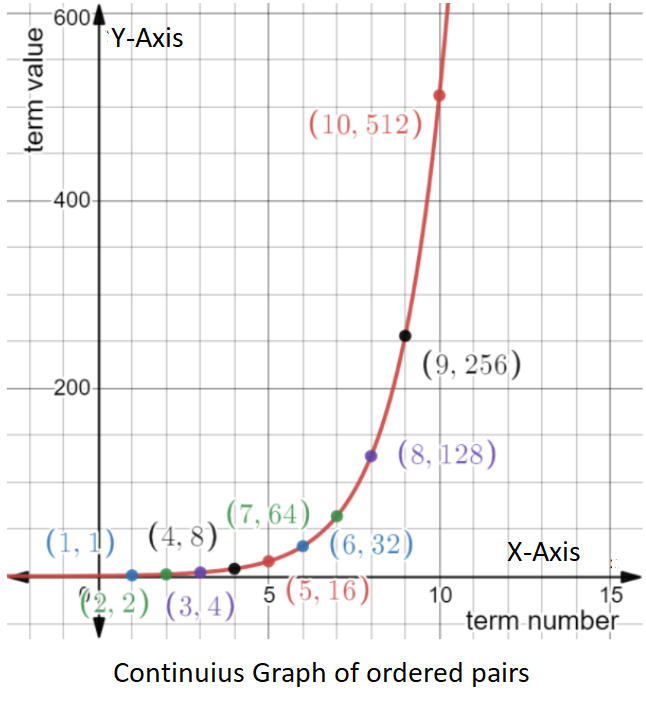
We get the shape of the graph of term value with number of term as increasing exponential form for given sequence.
So, the shape of the graph of term value with the number of terms is in increasing exponential form for a given sequence, given as,
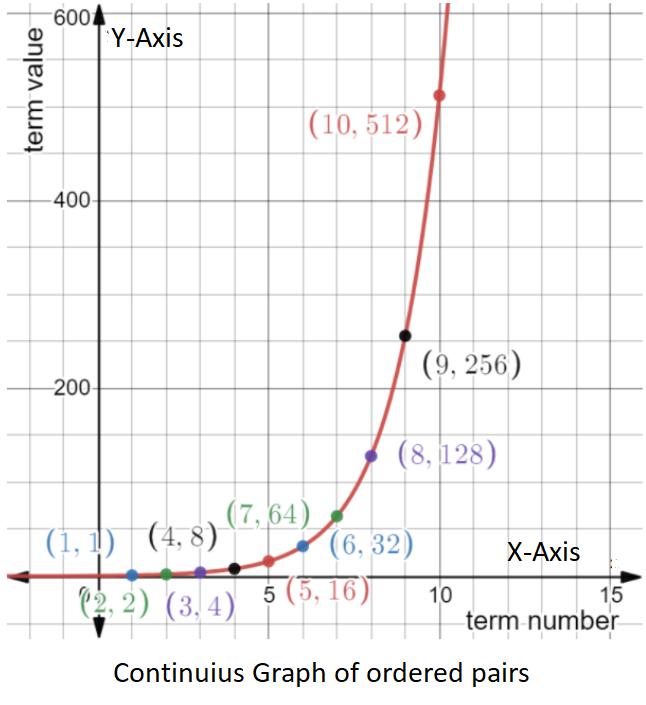
Carnegie Learning Algebra I Student Text Volume 1 3rd Edition Chapter 4 Exercise: 4.4 Sequences Page 254 Problem 11 Answer
We have been given an explicit formula as, gn=2n−1.
We have to find the continuity of the graph.
We can refer to the graph we drew with the ordered pairs.
The graph we drew is,

The term numbers must be natural numbers so the graph is discrete since continuous graphs have a domain of all real numbers.
As the points are not joined, we can say that the graph is discrete.
So, we get the graph as discrete as the term numbers must be natural numbers so the graph is discrete since continuous graphs have a domain of all real numbers, which is given as,
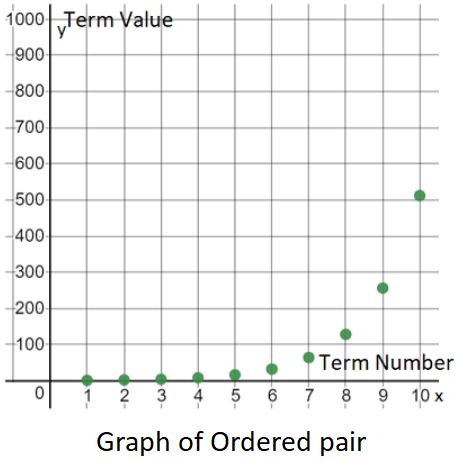
Page 254 Problem 12 Answer
We have been given an explicit formula as, gn=2n−1.
We have to find the 20th term of this sequence.
We will use the method of arithmetic sequence.
We can also use the continuous graph to determine the term.
The graph is given as,

As we have joined the points and can extend the graph, we might be able to find the 20th term of the graph.
So, using the continuous graph,
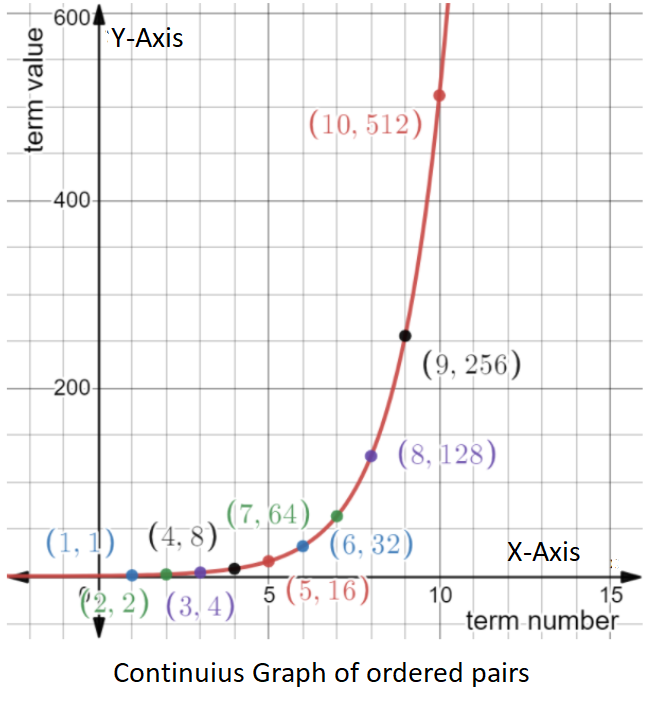
if we extend the graph, we can find the 20th term of the sequence.
Page 256 Problem 13 Answer
We have been given twelve different graphs.
We have to cut the graphs.
For each graph, we have to write its explicit and recursive formula.
We also have to write whether the graph is arithmetic or geometric.
We can say that the graph is arithmetic when its continuous graph is a straight line and geometric if it is any other curve.
So we can make its graphic organizer as,

So, for each graph, we wrote its explicit and recursive formulas, stated whether it is arithmetic or geometric, and made its graphic organizer as,

Page 261 Problem 14 Answer
We have to tell whether the sequences were increasing or decreasing.
We also have to explain whether increasing or decreasing helps us to match the graphs to their corresponding sequences.
We will do it using the method of sequences.
To explain whether the graphs were increasing or decreasing, we can sort the graphs in the correct order of A, B, C, E, F, H, I, J, K, M, N, and P.
We can say that if they hadn’t been though, knowing if the sequence was increasing or decreasing would allow us to eliminate some of the graphs as possible choices for the sequence.
So, we can say that it won’t help us.
So, we determined that knowing the sequences were increasing or decreasing doesn’t help us to match the graphs to their corresponding sequences as it is possible that it would allow us to eliminate some of the graphs as possible choices for the sequence.
Exercise 4.4 Sequences Explained
Carnegie Learning Algebra I Student Text Volume 1 3rd Edition Chapter 4 Exercise: 4.4 Sequences Page 261 Problem 15 Answer
We have been given the strategies to match the graph.
We have to find other strategies to match the corresponding sequence.
We will do it using the method Carnegie Learning Algebra in Sequence.
To find the other strategies to match the corresponding sequence, we sort the given graphs that are already in the correct order of A, B, C, E, F, H, I, J, K, M, N, and P, where no other strategies were needed.
If we were not given the correct order, then to determine which graph matched with which sequence we would have looked to see if the graph should be exponential (geometric) or linear (arithmetic),
We would have also seen whether the graph is increasing or decreasing and then found points on the graph if necessary to eliminate the choices down to one graph.
So, we matched the graphs to their corresponding sequence which are the given graphs that are already in the correct order of A,B,C,E,F,H,I,J,K, M,N,And P so no other strategies were needed.
Page 277 Problem 16 Answer
We have been given the graphs of the Arithmetic sequence as,
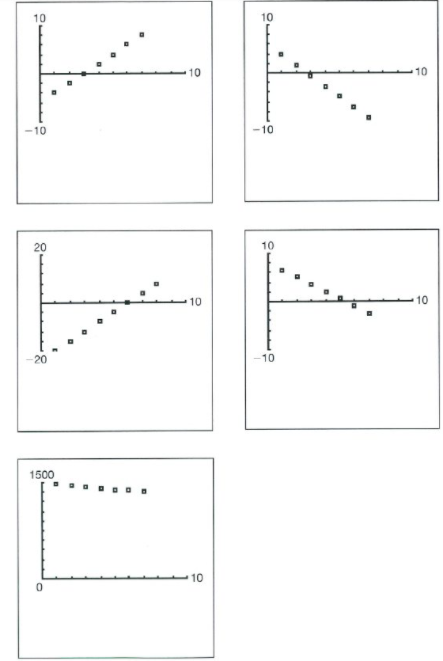
We have to identify the function family that represents the graph of the arithmetic sequence as shown and think all arithmetic sequence belongs to this function family.
Our reasoning is the graphs belong to the linear function family.
We know that the graph of any arithmetic sequence is linear because both arithmetic sequence and linear functions have a constant rate of change.
We can say that the points for the graphs of the arithmetic sequences all lie on a straight line so they are part of the linear function family.
So, we can also say that all arithmetic sequences belong to this family since arithmetic sequences have a constant rate of change (the common difference) which makes them linear.
So, with the help of graphs,
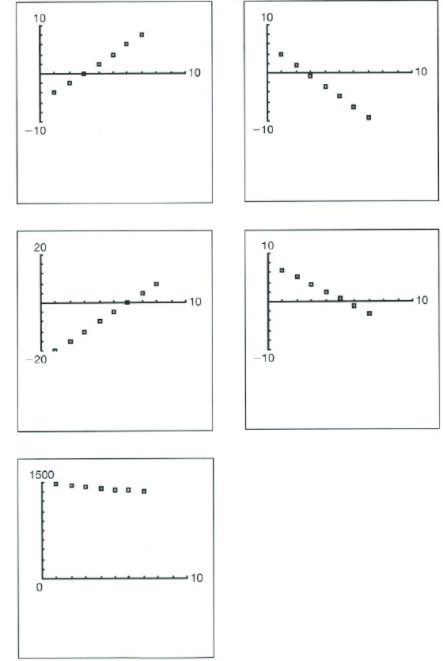
we can say that the function family that represents the graphs of the arithmetic sequences shown is the linear function family, and we can say that all arithmetic sequences belong to this function family as the rate of change in terms, which is a common difference, is constant in an arithmetic sequence.
Page 278 Problem 17 Answer
We have given an explicit formula of the Arithmetic sequence an=4+(−9/4)(n−1).
We need to find and rewrite explicit formulas in function notation.
We are going to use the concepts of Arithmetic progression.
We have: an=4+(−9/4)(n−1)
Let the function notation bef(x)
f(n)=4+(−9/4)(n−1)
f(n)=4−9n/4+9/4
f(n)=16−9n+9/4
Therefore,f(n)=25/4−9n/4.
The function notation for the arithmetic sequence an=4+(−9/4)(n−1) is
f(n)=−9/4n+25/4.
Carnegie Learning Algebra I Student Text Volume 1 3rd Edition Chapter 4 Exercise: 4.4 Sequences Page 278 Problem 18 Answer
We have given an explicit formula of Arithmetic sequence:an=−20+4(n−1).
We need to find and rewrite explicit formulas in function notation.
We will be using the concepts of Arithmetic progression to solve the question.
We have: an=−20+4(n−1)
Let the function notation bef(n),
f(n)=−20+4(n−1)
f(n)=−20+4n−4
f(n)=4n−20−4
Therefore,f(n)=4n−24.
The function notation for the arithmetic sequence an=−20+4(n−1) is f(n)=4n−24.
Page 278 Problem 19 Answer
We have given an explicit formula of the Arithmetic sequence an=6.5+(−1.5)(n−1). We need to find and rewrite explicit formulas in function notation.
We will be using the concepts of Arithmetic progression.
We have: an =6.5+(−1.5)(n−1)
Let the function notation be f(n),
f(n)=6.5+(−1.5)(n−1)
f(n)=6.5−1.5n+1.5
f(n)=−1.5n+6.5+1.5
Therefore,f(n)=−1.5n+8
The function notation for the arithmetic sequence an=6.5+(−1.5)(n−1) is f(n)=−1.5n+8.
Page 278 Problem 20 Answer
We have given an explicit formula of Arithmetic sequence, i.e., an=1473.2+(−20.5)(n−1).
We need to find and rewrite each explicit formula in a function notation.
We will be using the concepts of Arithmetic progression.
We have: an=1473.2+(−20.5)(n−1)
Let the function notation be f(n),
f(n)=1473.2+(−20.5)(n−1)
f(n)=1473.2−20.5n+20.5
∴f(n)=1493.7−20.5n
The function notation for the arithmetic sequence an=1473.2+(−20.5)(n−1) is f(n)=−20.5n+1493.7.
Chapter 4 Exercise 4.4 Carnegie Learning Guide
Carnegie Learning Algebra I Student Text Volume 1 3rd Edition Chapter 4 Exercise: 4.4 Sequences Page 278 Problem 21 Answer
We have given a family of arithmetic sequences.
We need to identify the function family of these arithmetic sequences.
We will be using the concepts of arithmetic sequences and arithmetic formulas.
We need to identify the function family of these arithmetic sequences,
Each formula is of the form f(n)=mn+b ,
We know that the above formula is equivalent to the slope-intercept form of a liney=mx+b
Therefore, the function of the family of these arithmetic sequences is a part of the linear function family.
Based on the formulas, we can conclude that the function of the family of these arithmetic sequences is a linear function.
Page 278 Problem 22 Answer
We need to find what is the relationship between the common difference of an arithmetic sequence and the slope of a linear function.
We will be using the concepts of the arithmetic sequence to solve the question.
We are also going to use the fact that the common difference between arithmetic sequence and slope of a linear function is the same value.
We need to find what is the relationship between the common difference and the slope of the linear function,
We are using the fact that the common difference of an arithmetic sequence is equal to the slope of the linear function
Since the common difference is the rate of change, which is the slope.
By following the concepts of arithmetic progression, we can conclude that the common difference and slope of a linear function are the same value.
Carnegie Learning Algebra I Student Text Volume 1 3rd Edition Chapter 4 Exercise: 4.4 Sequences Page 279 Problem 23 Answer
We have given a statement in which Hank says that the y-intercept of a linear function is the same as the first term of an arithmetic sequence.
We need to find out whether Hank is correct or not.
We will be using the concepts of an arithmetic sequence to solve this question.
To find is he correct.
Hank says that the y−intercept of a linear function is the same as the first term of an arithmetic sequence.
Hank is incorrect.
The y-intercept of an arithmetic sequence of the form f(n)=mn+b is when n=0 but the first term is when n=1.
Hank is incorrect because the y-intercept of an arithmetic sequence of the form f(n)=mn+b is when n=0 but the first term is when n=1.
Page 279 Problem 24 Answer
We have given the y-intercept of an arithmetic sequence algebraically.
We need to represent the y-intercept of an arithmetic sequence algebraically.
We are going to use the concepts of the arithmetic sequence to solve the question.
To represent the y-intercept of an arithmetic sequence algebraically
Rewriting the explicit formula an=a1+(n−1)d in function notation gives:
an=a1+(n−1)d
f(n)=aa1+(n−1)d
=aa1+dn−d
=dn+aa1−d
Comparing this to the slope-intercept form of a liney=mx+b gives, b=aa1−d so the y-intercept of an arithmetic sequence is aa1−d.
The y-intercept of an arithmetic sequence algebraically is aa1−d.
Page 281 Problem 25 Answer
We have given the graphs of the geometric sequences.
We need to find all of the graphs of the geometric sequences that belong to the same function family.
We are going to use the concepts of graphical representation.
To find do all of the graphs of the geometric sequences belong to the same function family.
No, the graphs of the geometric sequences do not belong to the same function family.
The graphs that are strictly increasing or strictly decreasing belong in the exponential function family but the graphs that have y-coordinates with alternating signs do not.
This is because exponential functions of the form f(x)=a⋅bx can only have b>0 but the sequences with alternating signs have b<0.
No, the graphs of the geometric sequences do not belong to the same function family.
Carnegie Learning Algebra I Student Text Volume 1 3rd Edition Chapter 4 Exercise: 4.4 Sequences Page 283 Problem 26 Answer
In this question, we have been given the geometric sequences that belong to the same function family.
We need to explain our reasoning.
By using the exponent rule, we will calculate the result.
The geometric sequences of the form f(n)=a⋅bn, are part of the exponential function family is b>0.
Some of the geometric sequences had b<0 though so they don’t all belong to the same function family since exponential functions can only have bases of b>0 and b≠1.
No, the geometric sequences do not belong to the same function family. Since some of the geometric sequences had b<0.
Page 284 Exercise 1 Answer
In this question, we have been given a geometric sequence and exponential function.
We need to find the relationship between the common ratio of a geometric sequence and the base of the power in an exponential function.
By using the exponent rule, we will calculate the result.
When writing a geometric sequence gn=ga1/rn−1 in function notation,gn
f(n)=ga1/rn−1
=ga1⋅rn⋅r−1
=ga1⋅rn⋅1/r
=ga1/r⋅rn
The common ratio of a geometric sequence and the base of the power in an exponential function are equal.
Since we Compare this to exponential functions of the form.
Page 284 Exercise 2 Answer
In this question, we have been given the geometric sequence and the exponential function.
We need to find the relationship between the first term of a geometric sequence and the coefficient of the power in an exponential function.
By using the exponent rule, we will calculate the result.
When writing a geometric sequence gn=a1/rn−1 in function notation,
Gn/f(n)=ga1 rn−1
=ga1⋅rn⋅r−1
=ga1⋅rn⋅1/r
=ga1/r⋅rn
The coefficient of the power in an exponential function is equal to the first term of the geometric sequence divided by the common ratio.
Page 284 Exercise 3 Answer
In this question, we have been given a linear function whose domain is the set of natural numbers.
We need to complete each statement with always, sometimes, or never and explain our reasoning for each statement.
By using the geometric sequence, we will calculate the result.
An arithmetic sequence can always be represented as a linear function with a domain of natural numbers Since the common difference of the sequence is the slope of the linear function.
An arithmetic sequence can always be represented as a linear function whose domain is the set of natural numbers
Carnegie Learning Algebra I Student Text Volume 1 3rd Edition Chapter 4 Exercise: 4.4 Sequences Page 284 Exercise 4 Answer
In this question, we have been given an exponential function whose domain is the set of natural numbers.
We need to complete each statement with always, sometimes, or never and explain our reasoning for each statement.
By using the geometric sequence, we will calculate the result.
A geometric sequence can sometimes be represented as an exponential function with a domain of natural numbers.
The common ratio of the sequence must be positive for it to be represented as an exponential function with a domain of natural numbers.
A geometric sequence can sometimes be represented as an exponential function with a domain of natural numbers.
Page 285 Exercise 5 Answer
In this question, we have been given an arithmetic sequence that will always begin in Quadrant 1.
We need to determine whether the statement is true or false.
By using the geometric sequence, we will calculate the result.
The arithmetic sequence will always begin in Quadrant 1 if all the values are positive.
An arithmetic sequence will always begin in Quadrant 1 is False.
The arithmetic sequence,−4,−2,0,2,… begins in Quadrant 4 since a1=−4 which is represented as the point (1,−4) in a graph.
The statement an arithmetic sequence will always begin in Quadrant1 is false.
Since the coordinate plane is split into four quadrants.
Carnegie Learning Algebra I Student Text Volume 1 3rd Edition Chapter 4 Exercise: 4.4 Sequences Page 285 Exercise 6 Answer
In this question, we have been given an arithmetic sequence that will never begin in Quadrant 3.
We need to determine whether the statement is true or false.
By using the geometric sequence, we will calculate the result.
The domain of an arithmetic sequence is the set of natural numbers that does not include negative values.
Quadrant 3 has only negative x-values so it is not included in the domain of the sequence.
If the arithmetic sequence is not the set of natural numbers then, it will never begin in Quadrant 3.
The statement an arithmetic sequence will never begin in Quadrant 3 is true. Since the coordinate plane is split into four quadrants.
Page 285 Exercise 7 Answer
In this question, we have been given a geometric sequence that will sometimes begin in Quadrant 2
.We need to determine whether the statement is true or false.
By using the geometric sequence, we will calculate the result.
If the domain of a geometric sequence is not the set of natural numbers then, a geometric sequence that will sometimes begin in Quadrant 2.
The domain of a geometric sequence is the set of natural numbers that does not include negative values.
Quadrant 2 has only negative x-values so it is not included in the domain of the sequence.
The statement a geometric sequence will sometimes begin in Quadrant 2 is false. Since the coordinate plane is split into four quadrants.
How To Solve Sequences Exercise 4.4
Carnegie Learning Algebra I Student Text Volume 1 3rd Edition Chapter 4 Exercise: 4.4 Sequences Page 285 Exercise 8 Answer
In this question, we have been given a geometric sequence that will always begin in Quadrant 4.
We need to determine whether the statement is true or false. By using the geometric sequence, we will calculate the result.
If the domain of a geometric sequence is not the set of natural numbers then, a geometric sequence will always begin in Quadrant 4.
A geometric sequence will always begin in Quadrant 4 is false.
The geometric sequence 2,4,8,16,32,… begins in Quadrant 1 since a1=2 which is represented as the point (1,2) in a graph.
The statement a geometric sequence will always begin in Quadrant 4 is false. Since the coordinate plane is split into four quadrants.
